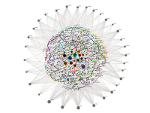 Outreach
Outreach
OUTREACH
Seminal paper by IFISC researchers on applications of chaos reaches 1000 citations
11 years ago, researchers from 6 European countries, collaborating within the European project OCCULT, coordinated by IFISC researcher Claudio Mirasso, published a seminal paper demonstrating the functional utilisation of complex dynamics in optics (1). The paper successfully demonstrated the utilisation of chaos for encrypted optical communication at GBit/second rates in the fiber-optic Metropolitan Area Network of Athens.
This week, the paper reached the milestone of 1000 citations, as counted by the Google Scholar platform.
The recognition of this work relies in its pioneering approach demonstrating the potential of complex dynamics for conventional and novel applications.
Meanwhile, members of three of the collaborating partners and co-authors of the paper (Claudio Mirasso, Pere Colet, Apostolos Argyris, Ingo Fischer) are working in IFISC, elaborating further the idea of harnessing complexity.
In recent years they have been demonstrating that complex behavior in optics can furthermore be utilised for ultra-fast random bit generation (2) and ultra-fast neuro-inspired photonic information processing (3).
1. Apostolos Argyris, Dimitris Syvridis, Laurent Larger, Valerio Annovazzi-Lodi, Pere Colet, Ingo Fischer, Jordi Garcia-Ojalvo, Claudio R Mirasso, Luis Pesquera, K Alan Shore, “Chaos-based communications at high bit rates using commercial fibre-optic links”, Nature, 438(7066), pp. 343-346 (2005).
2. N. Oliver, M.C. Soriano, D.W. Sukow, I. Fischer, “Dynamics of a semiconductor laser with polarization-rotated feedback and its utilization for random bit generation”, Optics Letters, 36(23), pp. 4632–4634 (2011).
3. D. Brunner, M.C. Soriano, C.R. Mirasso, I. Fischer, “Parallel photonic information processing at gigabyte per second data rates using transient states”, Nature Communications, 4, 1364 (2013).











